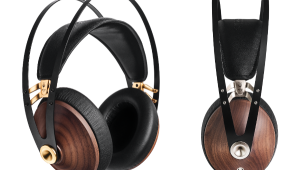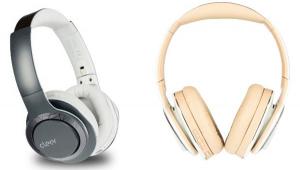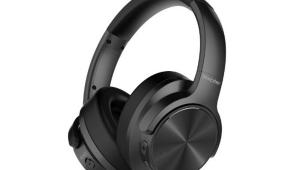Review: AKG K 490 NC and K 495 NC Noise-Canceling Headphones Page 2
Serious listening
I later sat down to give the AKGs a more serious listen. Because these are internally amplified headphones, when the noise cancellation is active you get little or no improvement by using a fancy headphone amp. Thus, I used my Motorola Droid Pro smartphone and iPod touch music player as sources, playing MP3, AAC, and Apple Lossless files.
I soon developed a preference for the K 490 NC, which has what I felt was a more natural tonal balance. What I liked most was the articulation and detail in the midrange and treble. In a comparison with the K 495 NC and two other on-ears, the V-Moda Crossfade M-80 and the TDK ST700, the K 490 NC produced the most detailed rendition of the strummed rhythm guitar part in the English Beat’s classic “Rough Rider.” On Toto’s “Rosanna,” its midrange and treble sounded the most neutral and natural of all the headphones, and its awesome ambience best captured that big sound the band was going for in its best recordings.
Voices sounded great through the K 490 NC. Male and female alike were clear and natural, with no bloating in the bass, no unnatural edge or emphasis in the treble, and no coloration that was anywhere near overt. The one discontinuity I noticed was an apparent slight emphasis in the mid- to upper-midrange, around 1.5 to 2 kHz.
The K 490 NC’s weak spot is its bass, which sounds tight and well-defined but is low in level. I wouldn’t go so far as to say the headphone sounds thin, but I definitely wouldn’t call it full, robust, meaty, satisfying, or any other adjective commonly heard at a steakhouse. There’s not much punch or groove here; the K 490 NC’s spaciousness may blow your mind but its bass won’t get your feet tapping. The Crossfade M-80’s midrange doesn’t sound as clean to me, but I know a lot of people will prefer its fuller sound.
The K 495 NC sounds like a near-opposite of the K 490 NC. Its bass-heavy, fat-sounding tonal balance lets it pump out a powerful groove, but the added bass seems to mask the treble somewhat. “Rosanna” sounded more like something out of the old Detroit Motown studio than a slick L.A. production. The bass had a somewhat soft character, without much pitch definition or punch.
To my ears, the K 495 NC’s treble sounded smooth but lacked detail. Some of the delicacy in the light, fingerpicked guitar part that opens “Shower the People” from James Taylor’s Live at the Beacon Theatre DVD was lost. The upper frequencies of vocals were also a bit toned-down; I could understand the words but lost a bit of the character of individual vocalists.
On most recordings, I preferred the K 490 NC’s more detailed sound. The one exception I found was “Right On, Y’all,” from Introducing the Eleventh House by Larry Coryell and the Eleventh House. “Right On, Y’all” sets fusion firebrands Coryell and Randy Brecker against a classic 1970s New York laid-back studio funk groove reminiscent of the original Saturday Night Live band. The K 490 NC did a better job of defining Coryell’s guitar and Randy Brecker’s trumpet in their unison lines, but the K 495’s powerful bass pulse drew me into the music more.
Measurements
I measured the K 490 NC and K 495 NC using a G.R.A.S. Type 43AG ear/cheek simulator, a Clio FW audio analyzer, and a Musical Fidelity V-Can headphone amplifier. Given the difficulty of getting a good seal with on-ear models on the simulator’s fake rubber ear, I tried numerous positions with each headphone and settled on positions that delivered the strongest bass response (and the best seal of the earpads against the simulator).
The K 490 NC’s frequency response plot blows me away, because the curves are essentially identical in passive and NC modes except for a slight increase in volume in NC mode. It’s a fairly flat response with an apparent roll-off in the high treble and a somewhat midrange-heavy balance. Adding a 70-ohm resistor in series with the V-Can’s 5-ohm output impedance to simulate driving with headphone with a typical low-quality amplifier barely affected the response at all, whether in active or passive mode.
The K 495 NC is a different story. With NC on, it shows something of the classic high-quality headphone response, with a mild bass boost, a midrange dip, and response peaks at 3 and 7.5 kHz. Switching into passive mode, with NC off, introduces a slight midrange boost around 600 Hz and substantially reduces bass response below 200 Hz. Again, adding an extra 70 ohms to the source impedance barely affected frequency response in either mode.
With one exception, distortion measurements for these headphones were outstanding. The K 490 NC barely ever exceeds 1% total harmonic distortion (THD) at 80 dB (measured using pink noise, A-weighted), and even at 100 dB it barely breaks 3% at 20 Hz in either mode. The K 495 NC is similarly excellent except at 100 dB in NC mode, where it’s obvious that the output signal from my Clio FW clipped the headphone’s internal amplifier, driving THD over 50% at 20 Hz. However, we never noticed this characteristic in our listening, because 100 dB is very loud. After seeing this measurement, I tried cranking up one of my favorite bass tests, “Falling” by the synth-pop group Olive, to see if I could get the K 495 NC’s bass to distort, but I couldn’t, at least not at any level I could stand to listen to.
The impedance of both headphones is essentially flat. The K 490 NC averages 36 ohms in passive mode and 151 ohms with NC on, while the K 495 NC averages 30 ohms in passive mode and 37 ohms with NC on.
Isolation is excellent in both models, especially for on-ear headphones. The K 490 NC has good isolation in passive mode, cutting external sound by -10 to -34 dB above 1.5 kHz. With NC engaged, isolation from 200 Hz to 1.5 kHz improves by an average of about -9 dB, and is effective even below 100 Hz. The K 495 NC’s isolation in passive mode is even better, cutting sound by -10 to -30 dB above 1 kHz, in a broader band than with the K 490 NC. Kicking in the K 495 NC’s noise cancellation produces an impressive -15 dB reduction in a band centered at 150 Hz.
Average sensitivity from 300 Hz to 10 kHz for the K 490 NC is 104.8 dB passive/106.2 dB active with a 1 mW signal at the rated 32 ohms impedance. For the K 495 NC, it’s 105.6 dB passive and 105.2 dB active with a 1 mW signal at the rated 26 ohms impedance.
Bottom line
Given that these are substantially different-sounding headphones, it’s tough for any one listener to recommend both. Based on the experience I and the other listeners had, I’d recommend you listen to both if you can and see which one appeals to you.
The K 490 NC is my clear favorite — like a great minispeaker, it’s light on the bass, ultra-clear in the mids and treble, and wonderfully spacious-sounding. Finding this level of sound quality in such a small form factor will be a relief for those who want great sound but don’t want to be burdened by traveling with a bulky headphone case.
The K 495 NC may have broader appeal because of its more bass-heavy balance, and my guess is that the average listener will prefer it to the K 490 NC. However, in my opinion, the discerning listener who wants a great-sounding noise-canceling headphone should go with the K 490 NC.
- Log in or register to post comments




































































